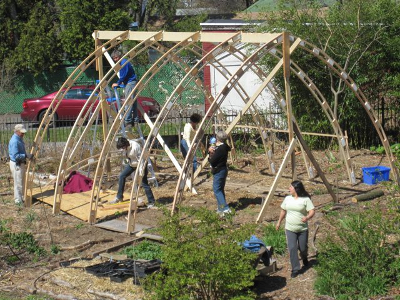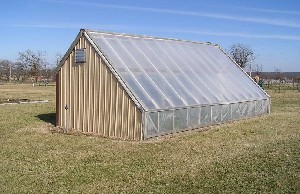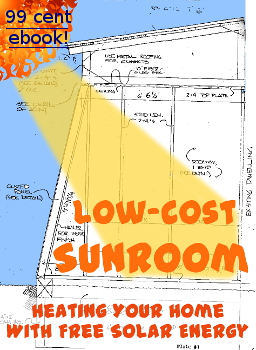
Bioshelter and passive-solar greenhouses
 I've
been pretty negative about the idea of a greenhouse in the past
because our quick hoops do a great job with cold-hardy crops, and I'm
simply not willing to heat a greenhouse to keep tropicals going all
winter. However, Paradise
Lot (which I'll
review later) included information on what they call bioshelter
greenhouses, one of which they report allows citrus to grow without
additional heat during Massachusetts winters. After some web
browsing, I realized that bioshelters are really just a rebranding of
what was called a passive-solar greenhouse in the 1970s --- both types
of structure are designed to keep a greenhouse as warm as possible with
no heat source other than the sun.
I've
been pretty negative about the idea of a greenhouse in the past
because our quick hoops do a great job with cold-hardy crops, and I'm
simply not willing to heat a greenhouse to keep tropicals going all
winter. However, Paradise
Lot (which I'll
review later) included information on what they call bioshelter
greenhouses, one of which they report allows citrus to grow without
additional heat during Massachusetts winters. After some web
browsing, I realized that bioshelters are really just a rebranding of
what was called a passive-solar greenhouse in the 1970s --- both types
of structure are designed to keep a greenhouse as warm as possible with
no heat source other than the sun.
 Websites galore sing the
praises of bioshelters, which some folks combine with fish ponds,
chickens, or rabbits to create a winter permaculture paradise.
However, I didn't find any data on nighttime low temperatures until I
stumbled across this
excellent page by
the Missouri Extension Service. Eric Lawman built a 12-by-24-foot
greenhouse, insulated on the north side and covered with two layers of
plastic on the south side, in zone 5 in Missouri. With the help
of twenty 55-gallon barrels, the greenhouse lows hover between about 35
and 45 Fahrenheit all winter long. The total construction cost
was $3,275 in 2005, and electricity is only used to run exhaust fans on
hot days and to run another small inflater fan to keep the two layers
of plastic spread apart on the south wall.
Websites galore sing the
praises of bioshelters, which some folks combine with fish ponds,
chickens, or rabbits to create a winter permaculture paradise.
However, I didn't find any data on nighttime low temperatures until I
stumbled across this
excellent page by
the Missouri Extension Service. Eric Lawman built a 12-by-24-foot
greenhouse, insulated on the north side and covered with two layers of
plastic on the south side, in zone 5 in Missouri. With the help
of twenty 55-gallon barrels, the greenhouse lows hover between about 35
and 45 Fahrenheit all winter long. The total construction cost
was $3,275 in 2005, and electricity is only used to run exhaust fans on
hot days and to run another small inflater fan to keep the two layers
of plastic spread apart on the south wall.
 Of course, even with the
heat problem dealt with, greenhouses do have the pest issue, but
information on such a well-designed passive solar greenhouse does push
me closer to considering the option. Maybe that would be the best
use of the sunniest spot in our core homestead --- the vertical bank on
the south-facing side of the gully.
Of course, even with the
heat problem dealt with, greenhouses do have the pest issue, but
information on such a well-designed passive solar greenhouse does push
me closer to considering the option. Maybe that would be the best
use of the sunniest spot in our core homestead --- the vertical bank on
the south-facing side of the gully.
Want more in-depth information? Browse through our books.
Or explore more posts by date or by subject.
About us: Anna Hess and Mark Hamilton spent over a decade living self-sufficiently in the mountains of Virginia before moving north to start over from scratch in the foothills of Ohio. They've experimented with permaculture, no-till gardening, trailersteading, home-based microbusinesses and much more, writing about their adventures in both blogs and books.
Want to be notified when new comments are posted on this page? Click on the RSS button after you add a comment to subscribe to the comment feed, or simply check the box beside "email replies to me" while writing your comment.

A while back I said that I'd build a modified lean-to greenhouse, and this is the design I had in mind. [BTW, thanks for the link to that page. Fantastic information!]
A few points of modification. The heat that rises to the peak can be vented and circulated with ducts to heat the 55-gal storage tanks. Also in the images they show additional tanks near the front wall for heat storage.
If the tanks are not closed and are connected to effectively make the 10 tanks into one large tank, a small sized rocket stove, not an RMH, could be added to heat/circulate heated water into stored heat system. Such a stove would burn scrap branches and would be needed rarely. [most likely late Dec into Jan and not many days at that.]
I'd insulate the 3 walls. The use of straw with the wood frame might work. Insulated SIPs could be per-orderd cut to size according to your blue prints.
If you'd like more info on SIPs and a greenhouse that circulate air from the peak, I'll post links.
The ribs of the greenhouse are a classic example of making an efficient and visually pleasing structural elements without using much material.
@Canned Quilter: Developements are under way to make replacements for oil-based plastics. Starch (from e.g. potatoes, corn, tapioca &c) treated with vinegar (fermented ethanol) and combined with glycerine (a by-product from biodiesel manufacture) or citric acid (from citrus fruits) as a plasticizer yields a transparent bio-based plastic. This is a process that everybody could do at home. You can watch people make it on youtube. Another related biopolymer is PLA, which is aleady commercially available. PLA was developed because it is more compatible with existing manufacturing methods like injection moulding, extrusion and film casting. And it can be made to bio-degrade relatively fast in a normal environment.
We love our greenhouse, and have found that the plastic lasts about 8 years before needing replacing. It is guaranteed for 4 years but that is about how much light is admitted due to yellowing etc., not for strength integrity. When we have replaced our cover, we have reused the poly to cover compost windrows, chicken greenhouse, etc. A well spent $300 for our needs anyway. Of course we are in a shadier climate, which may offer a little more life, and use a permanent installation of aluminum channel and springlock to apply the plastic so the combination of tight installation and cloudier climate may make some difference. Sloppy installation combined with wind are the worst enemies of greenhouse poly. When we need to replace the poly we pull out the spring lock and the channel remains, nothing is redone or wasted. To replace we just stretch the plastic, and spring lock it down.
For us the $300 spent over 8 years makes more sense by enabling us to extend our growing season, it allows us a more rounded diet and actually saves on fossil fuel because the food is grown right here.
Anna, to help alleviate pests you could remove your cover during the growing season and reapply during the winter when you want to use it the most.
You might also look into woven poly like Salatin uses on his hoophouses, we have used some of this for outside chicken shelters, and it is very durable.
http://www.northerngreenhouse.com/products/polys/wovenpolys.htm
About the time you were born I was designing passive solar greenhouses. We built 50 in Scott County. The principles are simple: A vertical, double glazed wall facing south A well-insulated roof East and west walls well insulated North wall protected with insulation and dirt embankment or against the south wall of a house Door into a house not to outdoors, if possible Reflective surfaces on all non glazed walls Solar mass such as black water filled barrels for heat storage Insulation under floor, such as polystyrene 4" under dirt, concrete or flooring
I left some glazing under your mother's side porch. It is a double walled 10 mm polycarbonate good for twenty years. 4x8 sheets of this are in the FarmTek Growers Supply catalog for $91.23 ea.